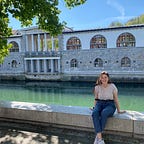Reflections on Vilnius: somewhere between orthodox and unorthodox.
This time last year, I was sitting in a bar in Slovenia with a good friend. We had a 7 am bus to Berlin airport to catch the following morning and having just fallen in love with Ljubljana, I was asking myself: how can anywhere possibly compete with this?
But Vilnius did compete. We flew to the Baltic state of Lithuania a few hours after our arrival in Berlin and travelled to its capital city by shuttle bus. Prior to our trip, a fellow traveller had described the city as “a bit rough around the edges”. And I can’t say that he was wrong. Whatever he meant by that, I like to see this ‘roughness’ as a blurring of the lines between an old and a new culture. Lithuania has had a rocky history; it suffered under
The country remains deeply religious, with 74.19% of Lithuanians aligning with Catholicism and 3.75% with the Eastern Orthodox denomination. And Vilnius won’t let you forget it. The city is home to 28 churches, with most adopting an open-door policy. For someone from a secular Western country, where Protestantism is the most popular religion, the gaudy portraits, dark candle-lit chambers, and sombre artwork represent a startling difference between British Protestantism and Eastern Orthodoxy. This, and the easy walkability of the city, makes it so easy to spend an entire weekend church-hopping.
In stark contrast to the confines of formal religion, residents of Vilnius have created a new community across the Vilnia River. The self-declared Republic of Uzupis is complete with its own constitution, unofficial currency, and government. The seriousness of the republic’s claims is up for debate due to its tongue-in-cheek attitude to autonomy, the fact that its national day lies on April Fool’s Day probably also doesn’t help. Uzupis attracts visitors through its peaceful atmosphere, ever-changing public art exhibitions, and quaint shops. While visiting the community we stumbled across the cat statue of Uzupis, with its bronze exterior now stained gold from all the affectionate hands that have met its nose. Touching the cat is said to rid a person of all their fears, anything’s worth a shot, right?
On what could be a more controversial note, Vilnius stakes a claim in the much-contested origin of the bagel. Regardless of whether or not this is true, it is definitely worth a trip to the Hales market hall to try it out. Not only is the food there affordable, but it is also high quality and offers some authentic insights into Lithuanian food and market culture — a tradition which dates back to 1604!
Also worth mentioning is the sheer amount of support that Lithuania showed Ukraine during our trip. The Ukrainian flag was draped in the window of what seemed like every second business, it flew from their administrative buildings and was even lovingly painted on the cheek of the Uzupis cat. Granted, our trip did take place only two months following the initial invasion, but I cannot imagine that such a strong show of support would ever waiver.
Vilnius proved itself to be a beautiful city, with a strong sense of community and empathy for those around them. It’s a city stuck between two eras: the traditional post-soviet era and the free modern era. I’m eager to see how this struggle between the two plays out in the decades to come.
